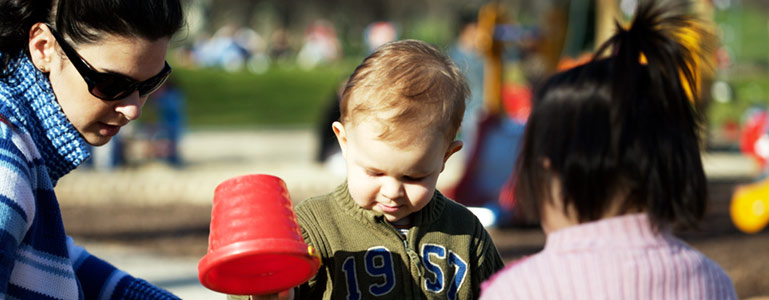Your 14-month-old is climbing on a chair and you are afraid that she will fall and hurt herself.
Your 3-year-old is playing in the sand area at the park, throwing the sand in the air, and showering other kids with sand.
Your 6-year-old is running around the house like a crazy person and roaring like a lion very loudly.
What do all these behaviors have in common? You probably feel the need to stop them, and your child needs re-direction. The younger the child, the more their behavior is a reflection of developmental skill level, temperament, and their need at the moment given their environment. Your child is fully engaged in whatever he/she is doing and not thinking about what could be done instead.
When you say: “Don’t climb on the chair”, or “Don’t throw the sand”, or “Don’t run and yell in the house” you aren’t helping your child think of something else to do. In fact you are actually reinforcing her own idea because by the time she really tunes into what you are saying, all she hears is “climb on the chair”, “throw the sand” or “run and yell in the house”. This is where Positive Re-Direction can be very helpful. If instead of just wanting your child to STOP, you think about what she is try to accomplish or needing to do at that moment, you can encourage her to do that activity instead.
Your 14-month-old is trying to learn how to sit on a chair and doesn’t know how to do it safely, so saying “Let’s keep your bottom on the chair” or “Let’s sit on the chair” tells her how she can use the chair safely —and of course you need to follow with physical guidance about how to actually get into a seated position.
Your 3-year-old is exploring with sand and isn’t aware of how other kids experience being showered with sand. Try saying: “The sand needs to be kept down low because your friends don’t like getting it in their hair. Look at your friend’s face; she looks unhappy about the sand in her hair. Here is a bucket. Show me how you can fill it up with sand.” This helps your 3-year-old tune into the children around him and also think of what he can do with the sand.
Your 6-year-old who is running and roaring in the house has a lot of energy that needs to be expressed, so saying: “Wow it looks like you have a lot of energy right now! If you feel like running and roaring like a lion, let’s go outside!” tells her how she can appropriately meet her need to be active.
I learned the language of Positive Re-Direction when I was a student teacher at Bing Nursery School at Stanford University. It took some practice to become a habit, but after a short time I noticed that it really is easy to simply tell a child what you want her to do instead of what you don’t want her to do, remembering to think about what she is trying to accomplish at the moment and guiding her into getting that need met.
Try Positive Re-Direction! You will be amazed at how much more cooperative your child becomes. And then try it on your partner too—it actually works with people of all ages!
Stephanie Agnew is the Assistant Director of Parents Place on the Peninsula. She is available for individual consultation on this and many other topics including Positive Discipline, Preschool and Elementary School Choices, and Kindergarten Readiness. To schedule a consultation or get more information call 650-688-3046.
Join us for our 2-part workshop, Parenting the Positive Discipline Way, at Parents Place, San Mateo, June 21 and 28.

